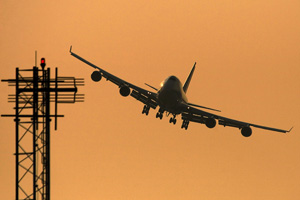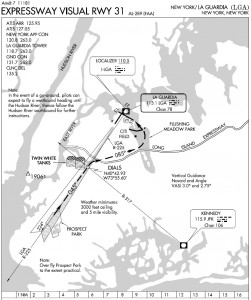(Editors note: Few things get a pilot’s -or avgeek’s- blood pumping faster than a twisting, turning approach to landing. Today’s Throwback Thursday feature takes a look at some of the challenging approaches regularly flown by airline pilots on a regular basis. This article was originally published in October 4, 2011.)
For most pilots, the transition from being aloft to touchdown typically terminates at the end of a glide slope and localizer. The negotiation of an ILS (Instrument Landing System) approach is one that for most aviators is a routine event which has lead to stable approaches and a sense of familiarity no matter where in the world the approach is attempted. In the 50 or so years since the introduction of the ILS, my guess is that hundreds, if not thousands, of accidents have been avoided by having vertical as well as lateral guidance all the way down to the runway.
While flying a straight-in ILS approach is typically the order of the day, most airline pilot’s relish at the opportunity to show they still have the right stuff and hand fly one of the few remaining non-ILS approaches left around the world. These approaches are becoming increasingly rarer and the ones that still do exist typically abut some pretty serious topography, or, have the approach corridor designed around very tight airspace restrictions. A great example of an approach that offered pilots a significant challenge was the IGS (Instrument Guidance System) to Runway 13 at Hong Kong’s now closed Kai Tak airport. The IGS was essentially an ILS approach that instead of being straight into the runway was offset by 47 degrees due to a mountain next to the airport. There are some unbelievable pictures and videos of huge jets attempting this approach in rather nefarious conditions floating around the internet. The approach started over Stonecutters Island, and then led the aircraft down between the rooftops of Kowloon, where at 700 feet, a tight right turn was executed to line up with the runway. All the while the pilots needed to be vigilant for the mountains to the left, as well as those directly ahead of the aircraft in the event of a go-around. It didn’t matter if you were landing or not, but when you got to the missed approach point (identified visually by a large checkerboard hence the nickname, “The Checkerboard Approach”), the pilot banked hard to the right either landing or executing a go-around. Throw in the effects of a passing typhoon and you had the ingredients for a significant challenge for the pilots guiding their ships to the ground within the basin of the Pearl River Delta. New York City offers a similar opportunity on an almost daily basis for professional airmen to show off their skills as they negotiate the myriad different types of approaches that don’t terminate at the end of a localizer or glide slope. The difference between New York and Hong Kong though, is that New York doesn’t present the same topographical challenges as Hong Kong does. Fortunately (or unfortunately depending on your viewpoint), the New York City airspace system has three of the busiest airports in the world all located with about twenty miles of each other. With LaGuardia Airport in the center and with Newark and John F. Kennedy International flanking the city’s smallest airport to the west and east respectively, the airspace designers had a bit of a problem on their hands. How were they to design an airspace system allowing the typical ten mile straight-in ILS? Easy. They couldn’t! The result of such tight airspace constraints is that it gave birth to some of the most interesting and fun approaches you can shoot in our world of straight-in, run-of-the-mill ILS approaches. Ask any pilot for their reaction when the ATIS at LaGuardia is calling for the Expressway Visual to Runway 31, and you will get a happy pilot. The same goes for an arrival into JFK via the VOR Approach to Runway 13L/R. It just doesn’t get any better for the individual that is going to handle tens of thousands or even hundreds of thousands of pounds of aluminum to a landing at LaGuardia or Kennedy. While JFK and LGA offer more than just these two non-ILS approaches, it is these particular two that offer the most challenge to airline pilots. The Expressway Visual gets its name from the route that the flight path follows. If you have ever been stuck in traffic on the Long Island Expressway in Queens, you’ve probably noticed airplane after airplane flying over your head. Airliners begin their descent to Runway 31 from just south of Coney Island. They track the localizer to Runway 4 until the course intercepts the Long Island Expressway about 5 miles from the airport. At this point the pilots execute a hard right turn to follow the expressway which guides the aircraft about a mile to the east of the airport. With the airplane fully configured with the landing gear and flaps set, at about 800 feet a hard descending left hand turn is entered as the aircraft wraps around Citi Field, home of the New York Mets. Depending of the rate of turn, most airliners are lined up with the 7,000 foot runway by about 300 feet above the ground and the result is a nice landing (hopefully) followed by a maximum effort to get the aircraft stopped on LaGuardia’s short 7,000ft Runway 31. This approach always requires the maximum in airmanship, mental math, and aircraft handling skill to culminate in a successful landing. It is done hundreds of times a day, a testament to the professionalism and ability of our nation’s airline pilots.

Late corrections on a JFK VOR/DME 13L approach. (Photo by Ander Aguirre)
Over on the south side of the Borough of Queens, another drama unfolds with the arrival of six and seven hundred thousand pound widebody aircraft negotiating the VOR Approach to Runways 13 Left and Right. Typically level at 3,000 feet paralleling Sandy Hook, New Jersey, an airliner on approach will cross ASALT intersection and begin a descent to cross the Canarsie VOR at 1500 feet while threading its route of flight between Breezy Point and Kingsborough Community College on the West Side of Rockaway Inlet. As the flight progresses the crew configures for landing and as they cross the Canarsie VOR, they track the Belt Parkway in a shallow descending banked turn all the way to the runway. As a guide, there are Lead-In lights that start about three miles from the runway that have sequenced flashing lights that help in guiding the airplane to the runway. These are especially helpful at night as JFK’s runways blend in very nicely with the neighborhoods around the perimeter of the airport in the darkness. As the aircraft is relatively low during this approach, it is tough to see the runway until you are almost lined up with it. Most aircraft land on Runway 13L which allows a slower, more gradual turn, but if you are landing on Runway 13R, the crewmembers must be prepared to execute a rather tight 90 degree right turn onto final approach. As if flying the approach isn’t fun enough, it sure is amazing to be sitting in traffic on the Belt Parkway and see a Boeing 747 in a descending banked turn 700 feet above your head. What is it with traffic in New York? It makes sense that a city with as much character as New York, offers pilots the chance to shoot approaches with just as much character. Dallas, Atlanta, Chicago, and Los Angeles just don’t present the typical airline pilot with the same opportunity to use their tricks of the trade the way New York does. This is not to say New York is the only city that offers pilots a chance to display their best stuff. The River Visual to Runway 19 at Washington’s National Airport is one for the ages as the pilot cranks and banks over the Potomac River ensuring they stay out of the prohibited airspace surrounding our nation’s capital. Want an aerial tour of Washington, D.C.? Just buy a ticket on the left side of any airplane flying into DCA and odds are if the wind is out of the south, you will be treated to a spectacular view as you soar within in arms reach of the White House, Lincoln Memorial, and Washington Monument.. The same goes for those flying into Portland, Maine. A chance to fly the twisting and turning Harbor Visual to Runway 29 in summertime is one of the most spectacular approaches to fly. There is nothing like hand flying an airliner around jagged islands and lighthouses, and over boats and twisting harbors on your way back to terra firma. A lobster roll and a cold beverage finish the experience off perfectly. On the ground that is. It is gratifying to know that we still have opportunities to be aviators and not just operators. As the late, great TWA Captain Bob Buck once said, “open biplanes with their tail skids taught you the skill of slipping, fishtailing, and S turning, maneuvers seldom seen today, but good to have tucked away in a pilot’s bag of tricks.” Well the machines of today don’t have multiple airfoils or open cockpits, but the fundamentals are still the same. There are still times when pilot’s need to use the skills that may have been atrophying in the background, but luckily there are still a few approaches out there that put our skills to the test. And these are the tests most of us are thrilled to take.
NYCAviation Columnist Justin Schlechter is a First Officer for an international airline and lives with his family on Long Island, New York.








